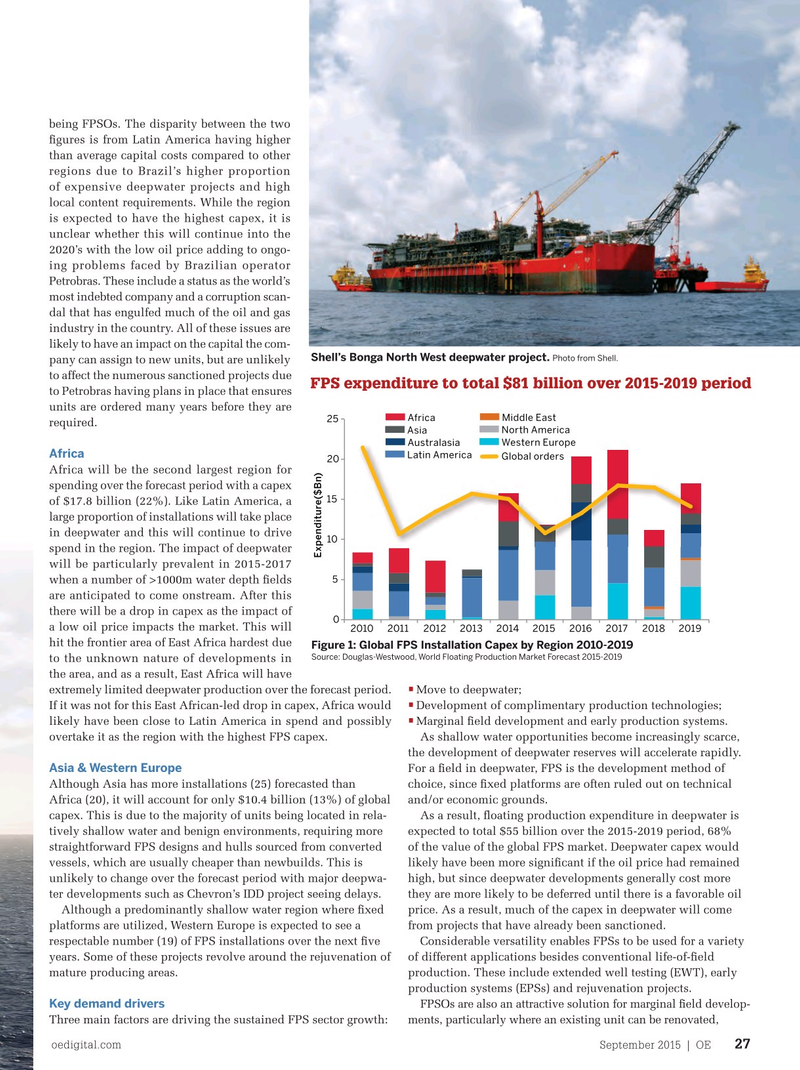
Page 25: of Offshore Engineer Magazine (Sep/Oct 2015)
Read this page in Pdf, Flash or Html5 edition of Sep/Oct 2015 Offshore Engineer Magazine
being FPSOs. The disparity between the two ? gures is from Latin America having higher than average capital costs compared to other regions due to Brazil’s higher proportion of expensive deepwater projects and high local content requirements. While the region is expected to have the highest capex, it is unclear whether this will continue into the 2020’s with the low oil price adding to ongo- ing problems faced by Brazilian operator
Petrobras. These include a status as the world’s most indebted company and a corruption scan- dal that has engulfed much of the oil and gas industry in the country. All of these issues are likely to have an impact on the capital the com-
Shell’s Bonga North West deepwater project. Photo from Shell.
pany can assign to new units, but are unlikely to affect the numerous sanctioned projects due
FPS expenditure to total $81 billion over 2015-2019 period to Petrobras having plans in place that ensures units are ordered many years before they are
Africa Middle East 25 required.
Asia North America
Australasia Western Europe
Africa
Latin America
Global orders 20
Africa will be the second largest region for spending over the forecast period with a capex 15 of $17.8 billion (22%). Like Latin America, a large proportion of installations will take place in deepwater and this will continue to drive 10 spend in the region. The impact of deepwater
Expenditure($Bn) will be particularly prevalent in 2015-2017 5 when a number of >1000m water depth ? elds are anticipated to come onstream. After this there will be a drop in capex as the impact of 0 a low oil price impacts the market. This will 2010 2011 2012 2013 2014 2015 2016 2017 2018 2019 hit the frontier area of East Africa hardest due
Figure 1: Global FPS Installation Capex by Region 2010-2019
Source: Douglas-Westwood, World Floating Production Market Forecast 2015-2019 to the unknown nature of developments in the area, and as a result, East Africa will have • extremely limited deepwater production over the forecast period. Move to deepwater; •
If it was not for this East African-led drop in capex, Africa would Development of complimentary production technologies; • likely have been close to Latin America in spend and possibly Marginal ? eld development and early production systems.
overtake it as the region with the highest FPS capex. As shallow water opportunities become increasingly scarce, the development of deepwater reserves will accelerate rapidly.
Asia & Western Europe
For a ? eld in deepwater, FPS is the development method of
Although Asia has more installations (25) forecasted than choice, since ? xed platforms are often ruled out on technical
Africa (20), it will account for only $10.4 billion (13%) of global and/or economic grounds. capex. This is due to the majority of units being located in rela- As a result, ? oating production expenditure in deepwater is tively shallow water and benign environments, requiring more expected to total $55 billion over the 2015-2019 period, 68% straightforward FPS designs and hulls sourced from converted of the value of the global FPS market. Deepwater capex would vessels, which are usually cheaper than newbuilds. This is likely have been more signi? cant if the oil price had remained unlikely to change over the forecast period with major deepwa- high, but since deepwater developments generally cost more ter developments such as Chevron’s IDD project seeing delays. they are more likely to be deferred until there is a favorable oil
Although a predominantly shallow water region where ? xed price. As a result, much of the capex in deepwater will come platforms are utilized, Western Europe is expected to see a from projects that have already been sanctioned. respectable number (19) of FPS installations over the next ? ve Considerable versatility enables FPSs to be used for a variety years. Some of these projects revolve around the rejuvenation of of different applications besides conventional life-of-? eld mature producing areas. production. These include extended well testing (EWT), early production systems (EPSs) and rejuvenation projects.
Key demand drivers FPSOs are also an attractive solution for marginal ? eld develop-
Three main factors are driving the sustained FPS sector growth: ments, particularly where an existing unit can be renovated, oedigital.com September 2015 | OE 27 026_OE0915_Feat1_DouglasWestwood.indd 27 8/19/15 9:07 PM

 24
24

 26
26